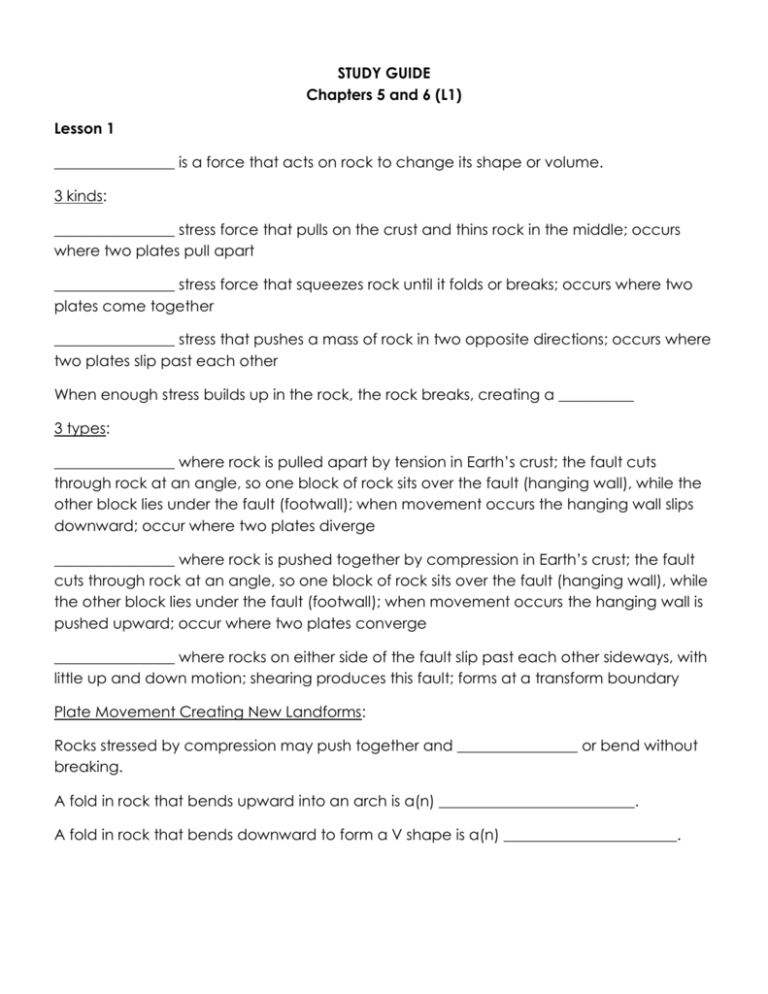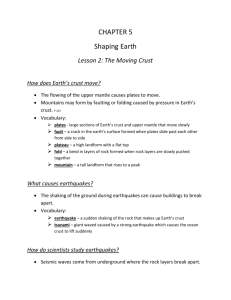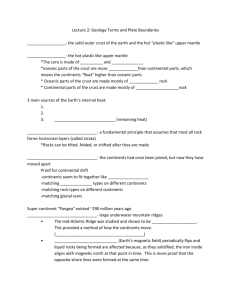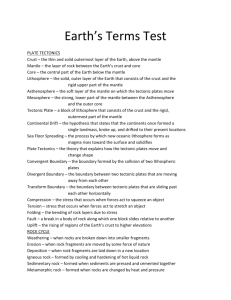Study Guide
advertisement

STUDY GUIDE Chapters 5 and 6 (L1) Lesson 1 ________________ is a force that acts on rock to change its shape or volume. 3 kinds: ________________ stress force that pulls on the crust and thins rock in the middle; occurs where two plates pull apart ________________ stress force that squeezes rock until it folds or breaks; occurs where two plates come together ________________ stress that pushes a mass of rock in two opposite directions; occurs where two plates slip past each other When enough stress builds up in the rock, the rock breaks, creating a __________ 3 types: ________________ where rock is pulled apart by tension in Earth’s crust; the fault cuts through rock at an angle, so one block of rock sits over the fault (hanging wall), while the other block lies under the fault (footwall); when movement occurs the hanging wall slips downward; occur where two plates diverge ________________ where rock is pushed together by compression in Earth’s crust; the fault cuts through rock at an angle, so one block of rock sits over the fault (hanging wall), while the other block lies under the fault (footwall); when movement occurs the hanging wall is pushed upward; occur where two plates converge ________________ where rocks on either side of the fault slip past each other sideways, with little up and down motion; shearing produces this fault; forms at a transform boundary Plate Movement Creating New Landforms: Rocks stressed by compression may push together and ________________ or bend without breaking. A fold in rock that bends upward into an arch is a(n) __________________________. A fold in rock that bends downward to form a V shape is a(n) _______________________. Sometimes mountains and valleys are formed due to tension in Earth’s crust. Such mountains are called ________________________ mountains. This happens when two plates move away from each other creating many _________________ faults. Forces that raise mountains can also uplift, or raise a large, flat block of Earth called a _____________________. This rock has many different flat layers and is wider than it is tall. Lesson 2 A(n) _____________________________ is the shaking and trembling that results from movement of rock beneath Earth’s surface. Most are too small to notice. __________________________________ are vibrations that are similar to sound waves and travel through Earth carrying energy released by an earthquake. The ________________________ is the area beneath Earth’s surface where rock that was under stress begins to break or move. This action triggers the earthquake. The point on the surface directly above it is called the __________________________. Three main categories: _________ waves: the first waves to arrive; seismic waves that compress and expand the ground like an accordion; can damage buildings; can move through solids and liquids _________ waves: seismic waves that can vibrate from side to side or up and down; when they reach the surface can shake structures violently; cannot move through liquids _________ waves: move more slowly, but can produce severe ground movement that can make the ground roll like ocean waves or shake buildings from side to side The ____________________________________ scale rates the amount of shaking from an earthquake; rated by people’s observations and not instruments; scales uses roman numeral ranges (I-III, IV-VI, VII-IX, X-XII) An earthquake’s __________________________ is a single number that geologists assign to an earthquake based on the earthquake’s size. The ____________________________ scale rates the magnitude of earthquakes based on the size recorded by seismographs. However, news reports that mention this scale almost always are referring to the earthquake’s ______________________________________. When comparing an earthquake’s moment magnitude, each point on the scale represents the release of roughly ________ more energy. Geologists use _____________________________ to locate an earthquake’s epicenter. To do this you need to read a graph to find the ____________________ from the seismograph to the ____________________________. If you know the distance of ________ seismograph stations, you can draw circles around each station; the point where the three circles intersect is the ____________________________. Lesson 3 A _________________________ consists of a pen connected to a weight and a drum of paper that can rotate. Seismic waves cause the drum to vibrate, which in turn causes the pen to record the drum’s vibrations. The ________________ remains stationary while the ________________ moves. The pattern of (zigzag) lines called a __________________________ is the record of an earthquake’s seismic waves produced by a seismograph. The __________________ of the lines drawn by a seismograph is ______________ for a more severe earthquake or an earthquake closer to the seismograph. Can geologists currently predict when and where an earthquake may occur? ________ Maps created by geologists using past data from seismographs show that earthquakes often occur ________________________________________________________________. In the United States, where are the most frequent earthquakes located? _________________________________________________ Why? _____________________________ _____________________________________________________________________________________ What other location in the U.S. is there a more moderate risk? (lab activity we did – can also look at map on page 163) _______________________________________________________ What vast area of geologic activity do many of the world’s earthquakes occur? ___________________________________________________ What other natural force is common along these boundaries? _______________________________________________ Chapter 6 Lesson 1 A ______________________ is a mountain that forms in Earth’s crust when molten material, or magma, reaches the surface. _________________________ is the molten material in the mantle and is called _________________________ when it reaches the surface. Volcanic belts form along the __________________ of Earth’s plates. Volcanoes can occur where two plates ________________________ causing the crust to fracture. They can also occur where two plates ___________________________ and one plate sinks beneath the other causing magma to rise. The ____________________________________ is a major belt of volcanoes that rim the Pacific Ocean. When boundaries converge the resulting volcanoes sometimes create a string of islands called a(n) ________________________________________. However, not all volcanoes form along plate boundaries. Some are the result of _________________________________ in the Earth’s mantle where material from deep within the Earth’s mantle rises through the crust and melts to form magma. An example of this is ____________________________________ Park in Wyoming and the ___________________ Islands in the Pacific Ocean (one of the US 50 states). Review the chart below:






